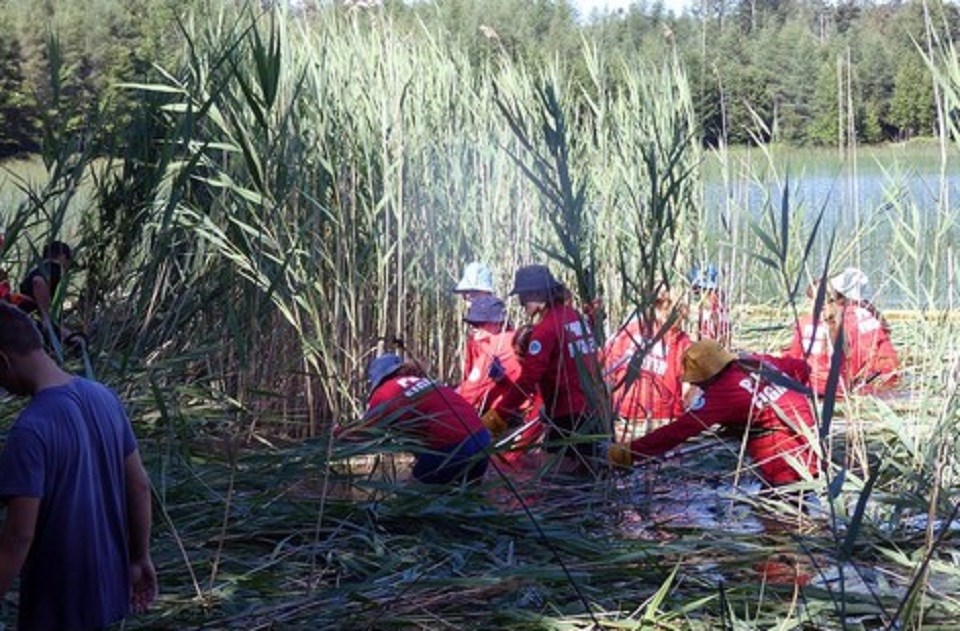Little by little the Lake Bernard Property Owners Association (LBPOA) and Phrag Fighters in Sundridge and the Township of Strong are making headway in their fight against phragmites.
Both groups hope they will be able to eradicate the invasive plant species in their area by 2030.
Phragmites grow and spread quickly, are found in both water and on land, and can overtake an area and choke out native plants.
They are also a threat to the fishery, turtle population, birds and amphibians.
Worse, they have no predators to help keep their numbers down.
See: New fund aims to control spread of invasive common reed
And: Phragmites: the 'bad boy' of invasive species
And: Fast invading plant threatening local wetlands
And: Five invasive plant species found in local area
Sherrie Berdusco, president of the association, says phragmites began making their way north during the 1990s and can now be found beyond Sault Ste. Marie.
They have been present in the Lake Bernard area for more than 10 years.
Phragmites spread easily from one area to another, with seeds embedded in the tires of all-terrain vehicles, when snowmobiles drive through a phragmites stand or when the plants get caught up in boat propellors.
Berdusco says while operating a boat, ATV or snowmobile is a great recreational activity, the same recreationalists are “being gardeners by helping to plant the seeds elsewhere.”
She says education and awareness will help reduce the spread of the plant.
“We continually spread the word about phragmites and the easiest way to get rid of them is to not get them in the first place,” Berdusco says.
“And if you do get them on your property, get rid of them fast.”
And for good reason.
Marilee Koenderink is a volunteer with the lead agency the Near North Enviro Education Centre in Sundridge and chairs the Phragmites Working Group Lake Bernard that falls under the education centre.
Koenderink says each pod on a phragmites plant contains up to 2,000 seeds. With that many seeds, it's easy to understand how the species proliferate.
It's why Lake Bernard property owners go into the lake each summer wearing hip waders and cut, spade or dig out the phragmites.
But Koenderink says it's “a tricky plant to get rid of.
“If you get to the plant early and there are only six, seven or eight of them, you can probably get rid of them fairly quickly,” Koenderink said.
“But the problem is 60 per cent of the plant is below ground. So imagine cutting a plant in front of you that's 15 or 16 feet tall. That plant extends more than another 30 feet underground. You're not going to get rid of it the first year. You have to do it season after season and follow up afterward to make sure it's all gone.”
The phragmites got out of hand on Lake Bernard over the years because Koenderink says at first “we didn't know enough about it.”
As a result, the early years saw only small numbers of the phragmites removed and some property owners didn't always carry out the cuts according to the book.
But they learned over time how to fight the plant and it's why Koenderink, Berdusco and the Phrag Fighters are confident Lake Bernard should be phragmites-free by 2030.
Koenderink says the goal over the next four summers is to wade into Lake Bernard and hit all the sites where the phragmites are present at least once, followed up with repeat visits.
“We've had good success,” Koenderink said.
“The sites we started cutting first had stalks that towered over us. Now they are small, close to the ground and we can use spades on them. In the past what took 18 people six hours to do now takes 10 people two-and-a-half hours to do.”
However, Koenderink can't emphasize enough that it's critical during the removal stage that the roots are totally removed because “they are very good at surviving.”
Both Berdusco and Koenderink say much of the success in eliminating the phragmites is due to the incredible partnerships in place.
For example, Koenderink says last year the Lake Bernard Phrag Fighters cut the phragmites at 34 sites and, after tying and bagging the plants, the municipalities of Strong, Joly and Sundridge made 85 truckload visits to the local landfill where the plants were either burned or buried.
Koenderink adds the LBPOA, the numerous property owners who belong to it and volunteers “are the success behind the cutting events.
“We could not function without the large number of volunteers who are committed to lake health.”
Late last year the LPBOA received a $5,000 grant from the Green Shovels Collaborative, a combined effort of several non-profit organizations that work together on key invasive species priority projects.
One of the non-profit organizations' partners is the Federation of Ontario Cottagers Association (FOCA) which the LBPOA belongs to.
The LBPOA won the $5,000 grant through FOCA which funds invasive plant-type projects.
The grant will help provide the Phrag Fighters with equipment, including bringing in an amphibious truxor which travels over the top of the water and cuts the phragmites.
Koenderink says from July 15 to Oct. 1, the volunteers will be wading hip-deep into Lake Bernard once again removing the phragmites.
She says they can't remove the plants before or their operation would also impact fish spawning season.
Outside that period, homeowners will be removing the land-based phragmites.
Koenderink says phragmites remain the No. 1 threat to wetlands and inland lakes across North America.
Rocco Frangione is a Local Journalism Initiative reporter who works out of the North Bay Nugget. The Local Journalism Initiative is funded by the Government of Canada.
